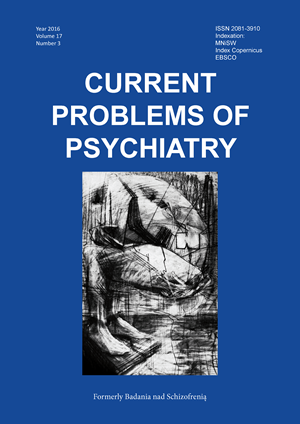Risk behaviors at late childhood and early adolescence as predictors of depression symptoms
DOI:
https://doi.org/10.1515/cpp-2016-0018Keywords:
risk behavior, depression, adolescenceAbstract
The study aims to answer following questions: (1) What are the risk behaviors among children at late childhood and early stage of adolescence? (2) What are the differences between boys and girls concerning problem behaviors? (3) Do risk behaviors predict symptoms of depression? Participants fulfilled the set of three tools: (1) Children Depression Inventory authored by M. Kovacs (1992); (2) List of experienced risk behaviors and (3) List of open questions concerning the knowledge and experience with smart drugs. The study group consisted of 130 boys and girls attending the fifth and sixth grade of primary school. The study shows differences between boys’ and girls’ risk behaviors, as well as the similarities. The findings indicate that gender-related disparities in problem behaviors exist even at the early stages of puberty. Boys under one parent custody declare significantly more risk behaviors than girls under one parent custody. Finally, the symptoms of depression were predicted by cumulative number of risk behaviors and – on tendency level – by type of parental custody.
References
1. Bannik R., Broeren S., Heydelberg J. Klooster E. Raat H. Depressive symptoms and clustering of risk behaviors among adolescents and young adults attending vocational education: a cross sectional study. Publ Health, 2015; 15 (4): 2-9.
2. Kosunen E.E., Kaltiala-Heino R., Rimpelä M., Laippala P. Risk taking sexual behavior and self-reported depression in middle adolescence – a school based study. Child: Care, Health Dev, 2003; 29 (5): 337-344.
3. Kosterman R., Hawkins D., Mason A., Herrenkohl T., Lengua L., McCauley E. Assessment of behavior problems in childhood and adolescence as predictors of early adult depression. J of Psychopath & Beh Assessment, 2009; 32 (1): 118-127.
4. Bobrowski K., Czabała Cz., Bykczyńska C. Risk behaviors as a dimension of mental health assessment in adolescents. Arch Psychiatr Psychotherapy, 2007; 1-2: 17-26.
5. Rew L., Horner S.D., Brown A. Health risk behaviors in early adolescence. Issues Comp Ped Nurs, 2011; 34: 79-96.
6. Wang R.H., Hsu H.Y., Lin S.Y., Cheng Ch. P., Lee S.L. Risk behaviors among early adolescents: risk and protective factors. J Adv Nurs, 2010; 66 (2): 313-323.
7. Meier A. Adolescent First Sex and Subsequent Mental Health. American Journal of Sociology, 2007; 112 (6): 1811-1847.
8. Eriksson I., Cater A., Andershed A.K., Andershed H. What protects youths from externalizing and internalizing problems? Critical review of research findings and implications for practice. Journal of Guidance and Counselling, 2011; 21 (2): 113-125.
9. Wolff J., Ollendick T.H. The comorbidity of conduct problems and depression in childhood and adolescence”. Clinical Child & Family Psychology Review, 2006; 9 (3-4): 201-220.
10. Zalk N., Kerr M., Tilton-Weaver L. Shyness as a moderator of the link between advanced maturity and early adolescent risk behavior. Scandinavian Journal of Psychology, 2011; 52 (4): 341-353.
11. Avery L., Lazdane G. (2008). What do we know about sexual and reproductive health of adolescents in Europe. The European Journal of Contraception and Reproductive Health Care, 2008; 13 (1): 58-70.
12. Jager J., Davis-Kean P. Same sex sexuality and adolescent well-being: the influence of sexual orientation, early reports on same-sex attraction, and gender. Self and Identity, 2011; 10 (4): 417-444.
13. Jackson Ch., Brown J., Pardum C. A TV in bedroom: implications for viewing habits and risk behaviors during early adolescence. Journal of Broadcasting & Electronic Media, 2008; 52 (3): 349-367.
14. Ward L. Does television exposure affect emerging adults’ attitudes and assumptions about sexual relationships? Correlational and experimental confirmation. Journal of Youth & Adolescence, 2002; 31 (1): 1-15.
15. Guardini T., Marks A., Patton F., Coll C. The immigrant paradox in sexual risk behavior among Latino adolescents: impact of immigrant generation and gender. Appl Dev Sci, 2011; 15 (4): 201-209.
16. Shanklin S., Brener N., Kann L., Griffin-Blake S., Ussery-Hall A., Easton A., Barrett E., Hawkins J., Harris W.A., McManus T. Youth Risk Behavior Surveillance –Selected Steps Communities, Surveillance Summaries, 2007; 57 (12): 1-26.
17. Rola J. Upośledzenie umysłowe jako czynnik ryzyka dla depresji dziecięcej. Warszawa; Wydawnictwo WSPS: 1996.
18. Falci Ch. The effects of family structure and family process on the psychological well-being of children: from the children point of view. Master Thesis: Virginia Polytechnic Institute. Virginia USA; Blacksburg: 2006 https://theses.lib.vt.edu/theses /available/ etd-182516659751561/unrestricted/Falci.pd
19. Katon W., Richardson L., Russo J., McCarthy C., Rockhill C., McCauley E., Richards J., Grossman D. (2010). Depressive symptoms in adolescence: the association with multiple health risk behaviors. Gen Hosp Psychiatry, 2010; 32 (3): 233-239.
Downloads
Published
Issue
Section
License
Copyright (c) 2016 Authors

This work is licensed under a Creative Commons Attribution-NonCommercial-NoDerivatives 3.0 Unported License.


